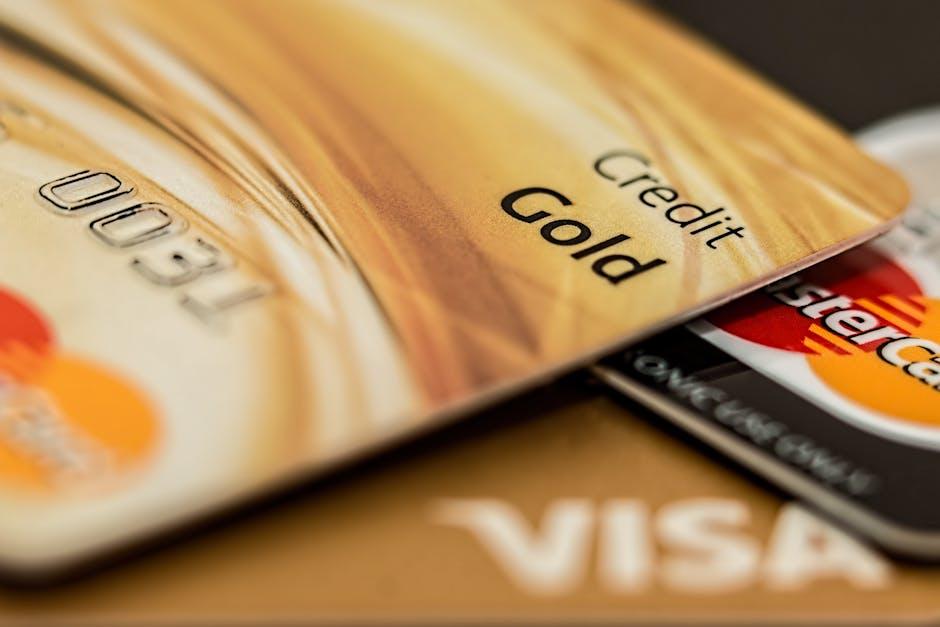In today’s fast-paced financial landscape, managing multiple credit cards can feel like a double-edged sword. On one hand, the potential for rewards, cash back, and enhanced purchasing power beckons, yet the prospect of misuse and accumulating debt looms large. Understanding how to navigate this complex terrain is essential for fostering not just financial literacy, but also success. This article delves into the strategies that empower consumers to harness the benefits of multiple credit cards while mitigating risks. From smart budgeting techniques to leveraging rewards programs, we’ll explore how mastering the art of credit card management can pave the way to a more secure and prosperous financial future.
Strategies for Choosing the Right Credit Cards for Your Financial Goals
Choosing the right credit cards for your financial goals involves a thoughtful approach tailored to your unique spending habits, credit profile, and long-term objectives. Here are some effective strategies to guide you:
- Understand Your Spending Habits: Analyze your monthly expenses to identify categories where you spend the most. Whether it’s groceries, travel, or dining out, knowing this will help you select cards that offer the best rewards.
- Prioritize Rewards vs. Interest Rates: Depending on your needs, you might prioritize high rewards rates or focus on cards with lower interest rates. If you pay your balance in full each month, rewards might take precedence.
- Consider Signup Bonuses: Many credit cards offer lucrative bonuses for new sign-ups. Look for cards that provide attractive offers after you meet a minimum spending requirement.
- Leverage Introductory Offers: Take advantage of 0% APR introductory offers on purchases or balance transfers to maximize your savings or manage debt effectively.
- Evaluate Annual Fees: Some credit cards come with annual fees that may or may not be worth the cost. Weigh the benefits against the fee to determine the card’s overall value.
- Check Your Credit Score: Different cards have varying credit score requirements. Regularly check your score to ensure you’re applying for cards you’re likely to be approved for.
- Utilize Card Features: Look for features like fraud protection, travel insurance, or rental car coverage that can enhance the overall value of the card.
- Monitor Your Usage: Regularly track how you use your credit cards to see if they align with your goals. Adjustments might be necessary based on changes in your spending or financial situation.
| Card Type | Ideal For | Key Features |
|---|---|---|
| Cash Back | Everyday Expenses | Flat percentage on all purchases or higher rates in specific categories. |
| Travel Rewards | Frequent Travelers | Points for flights, hotels, and other travel-related expenses. |
| Low Interest | Debt Management | Lower APR for carrying a balance, ideal for making larger purchases. |
| Student Cards | Young Adults | Building credit with lower limits and no annual fees. |
By carefully evaluating these aspects, you can select credit cards that not only meet your immediate needs but also support your long-term financial journey.

Maximizing Rewards and Benefits from Your Card Portfolio
To maximize rewards and benefits from your credit card portfolio, consider implementing these effective strategies that can greatly enhance your earning potential:
- Understand Your Spending Habits: Identify categories where you spend the most-such as groceries, travel, or dining out-to select cards that offer enhanced rewards in those areas.
- Utilize Welcome Bonuses: Many cards offer substantial sign-up bonuses. Make sure to meet the spending threshold within the specified time frame to maximize initial rewards.
- Leverage Multiple Cards: Use different cards for particular purchases to maximize rewards across various categories. For example, use a travel rewards card for flights and a cash back card for grocery shopping.
- Pay Attention to Rotating Categories: Some cards offer higher rewards for specific categories that change quarterly. Keep track of these to ensure you’re capitalizing on the highest earnings possible.
- Take Advantage of Offers and Promotions: Regularly check your card issuer’s website or app for limited-time offers and extra points for specific merchants.
- Redeem Rewards Wisely: Look for options to redeem rewards that provide the best value, such as transferring points to travel partners or using points for high-value merchandise.
- Stay Aware of Fees: Choose cards with no annual fees or weigh the benefits against the costs to ensure that you are not losing out on rewards due to hidden charges.
- Monitor Your Credit Score: A healthy credit score can open doors to better credit cards with higher rewards. Regularly check your score and take steps to maintain or improve it.
| Card Type | Rewards Rate | Annual Fee | Bonus Offer |
|---|---|---|---|
| Cash Back Card | 1.5% – 6% on categories | $0 – $95 | $150 after $500 spent |
| Travel Rewards Card | 1x – 3x points | $0 – $550 | 50,000 points after $3,000 spent |
| Business Rewards Card | 1.5% – 5% on business expenses | $0 – $395 | 60,000 points after $5,000 spent |
By strategically selecting and using credit cards, you can create a powerhouse portfolio that maximizes your rewards and suits your financial needs. Don’t forget to revisit your selections periodically to ensure they still align with your lifestyle and spending patterns.

Understanding the Importance of Payment Timeliness and Credit Utilization
Effective management of multiple credit cards is not just about knowing when to swipe; it’s also about understanding the vital role that payment timeliness and credit utilization play in your financial health. Both factors can significantly impact your credit score and overall financial success.
Payment Timeliness
Making payments on time is crucial. Late payments can lead to a cascade of negative effects:
- Your credit score can drop significantly-often by 100 points or more.
- Late fees can accrue, making your credit card debt more expensive.
- Repeated late payments may lead to higher interest rates on existing debt.
Creditors report payment history to credit bureaus, and a record of on-time payments can bolster your score. Setting up automatic payments or reminders can help ensure you never miss a due date.
Credit Utilization
Credit utilization refers to the ratio of your current credit card balances to your total credit limits. It’s a key factor that credit scoring models consider:
- A utilization rate below 30% is generally seen as ideal.
- Rates above 30% can negatively impact your credit score.
- Even if you pay your balances in full each month, a high utilization rate can still hurt your score if you’re charged before the statement closes.
Managing your credit utilization involves:
- Spreading purchases across multiple cards to keep individual utilization rates lower.
- Requesting higher credit limits, which can improve your utilization ratio.
- Paying down existing balances regularly, not just at the end of the billing cycle.
Table of Ideal Payment Timeliness and Utilization Rates
| Factor | Ideal Range | Impact on Credit Score |
|---|---|---|
| Payment Timeliness | On Time (0 Late Payments) | 25-100 Points Increase |
| Credit Utilization | Under 30% | Varies; Higher Utilization = Lower Score |
The combined effect of timely payments and judicious credit utilization not only preserves your credit score but can also enhance your overall financial opportunities. Maintaining healthy payment habits and a balanced utilization ratio empowers you to leverage credit responsibly.

Navigating the Challenges of Multiple Accounts for Financial Health
Managing multiple credit card accounts can significantly enhance your financial health when done thoughtfully. However, it also presents several challenges that require careful navigation. Here are some essential strategies to ensure you’re using multiple accounts to your advantage:
- Understand Your Limits: Always be aware of your credit limit on each card. This will help you avoid overspending and maintain a healthy credit utilization ratio-ideally keeping it below 30% of your total credit limits.
- Track Due Dates: Juggling multiple payments can lead to missed due dates. Set reminders or use budgeting apps to keep track of your payment schedules. Late payments can hurt your credit score.
- Utilize Rewards Effectively: Each credit card may offer different rewards or cash back options. Make sure to align your spending with the card that provides the best benefits for specific categories like groceries, gas, or travel.
- Monitor Your Credit Score: Regularly check your credit score through services like Credit Karma or annualcreditreport.com. Understand how your multiple accounts affect your score and address any discrepancies promptly.
- Limit New Applications: Each time you open a new credit account, a hard inquiry affects your score. Be strategic about applying for new cards-focus on those that will genuinely enhance your financial position.
It’s also important to keep track of your overall financial picture. Here’s a simple table to visualize how to balance your spending across various cards:
| Card Name | Credit Limit | Current Balance | Utilization (%) |
|---|---|---|---|
| Visa Rewards | $5,000 | $1,200 | 24% |
| MasterCard Cash Back | $3,000 | $500 | 17% |
| Discover Travel | $7,000 | $1,800 | 26% |
By effectively managing multiple credit accounts, you not only improve your purchasing power but also establish a solid foundation for long-term financial success. Remember to review your accounts regularly and adapt your strategy as your financial situation evolves.

Key Takeaways
In conclusion, mastering multiple credit cards can be a powerful tool in your financial arsenal. By strategically managing your credit, you not only build your credit score but also unlock a world of rewards and benefits. Remember to stay organized, monitor your spending, and pay your balances on time to harness the full potential of your cards. With careful planning and mindful use, you can navigate the complexities of credit with confidence and pave the way for a brighter financial future. Embrace the journey of smart financial success, and let your credit cards work for you, not against you.














